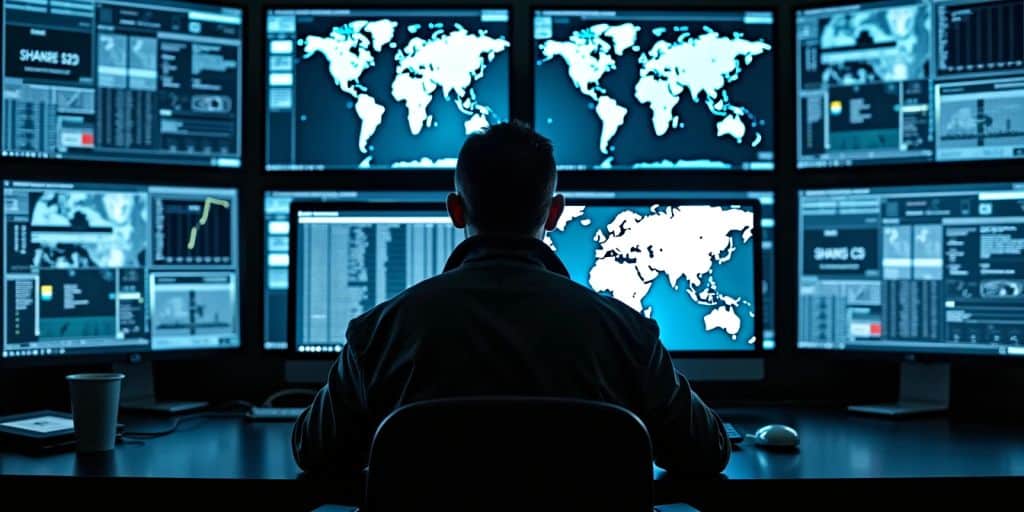Black Ops projects are secret missions often carried out by government agencies like the CIA. These operations are hidden from the public and involve risky tasks to gather intelligence, influence global politics, or eliminate threats. This article uncovers the role of Black Ops in modern espionage, the importance of human intelligence, the ethical issues involved, and how technology is changing these covert missions.
Key Takeaways
- Black Ops projects play a crucial role in gathering intelligence and influencing global politics.
- Human intelligence (HUMINT) is vital for the success of Black Ops missions.
- These operations often raise ethical and political questions.
- Technological advancements are transforming the way Black Ops are conducted.
- Famous Black Ops missions, like the hunt for Osama Bin Laden, highlight the impact and risks of these secret operations.
The Role of Black Ops Projects in Modern Espionage

Historical Context and Evolution
Black Ops projects have a long history, evolving significantly over the decades. Initially, these operations were simple and straightforward, but they have grown in complexity and scope. During the Cold War, for instance, the CIA’s role in covert missions expanded dramatically, reflecting the intense geopolitical climate of the time.
Key Objectives and Goals
The primary goals of Black Ops projects are to gather intelligence, disrupt enemy plans, and achieve strategic advantages without direct confrontation. These operations often involve a mix of human intelligence (HUMINT) and advanced technology to ensure success. The importance of HUMINT cannot be overstated, as it provides critical insights that technology alone cannot offer.
Impact on Global Politics
Black Ops projects have a profound impact on global politics. They can alter the course of conflicts, influence political decisions, and even change the balance of power between nations. The geopolitical climate during the Cold War, for example, was heavily influenced by covert operations, which were often shrouded in secrecy and speculation.
Human Intelligence in Black Ops Projects

Importance of HUMINT
Human Intelligence, or HUMINT, is a cornerstone of black ops missions. Black ops operatives rely on a variety of methods to obtain classified information, but HUMINT remains one of the most effective. This type of intelligence involves gathering information directly from human sources, making it invaluable for understanding enemy plans and intentions.
Techniques and Strategies
HUMINT operatives use a range of techniques to gather information. These include:
- Interrogation: Extracting information from captured individuals.
- Surveillance: Monitoring targets to gather actionable intelligence.
- Recruitment: Convincing insiders to provide critical information.
Each method requires a unique set of skills and carries its own risks and rewards.
Case Studies from the Field
One notable example of HUMINT in action is the role it played during the Contra Wars. Enrique "Ric" Prado, a former CIA officer, was pivotal in these operations. His efforts in human intelligence were crucial for the success of missions against the Sandinistas in Honduras. Another significant case is the tracking of Osama Bin Laden, where HUMINT was essential in locating and ultimately eliminating the terrorist leader.
The importance of human intelligence in black ops cannot be overstated. It provides insights that are often unattainable through other means, making it a critical component of modern espionage.
Ethical and Political Implications of Black Ops
Moral Dilemmas in Covert Operations
Black Ops projects often involve moral dilemmas that challenge the ethical boundaries of those involved. These operations can sometimes require actions that, while necessary for national security, may conflict with personal or societal morals. For instance, the use of controversial tactics like drone strikes or alliances with unsavory characters can lead to significant ethical debates.
Oversight and Accountability
Ensuring proper oversight and accountability in Black Ops is crucial. Without it, there’s a risk of abuse of power and misconduct. Various agencies, including the CIA, have faced scrutiny over their actions in covert missions. The balance between maintaining secrecy and ensuring accountability is a delicate one.
Public Perception and Controversies
Public perception of Black Ops projects can be highly controversial. When details of these operations become public, they can lead to significant backlash and debate. For example, the revelation of certain tactics used in the Contra Wars or the handling of detainees can spark widespread controversy and impact public trust in government agencies.
The ethical and political implications of Black Ops are complex and multifaceted, often leading to intense debates and scrutiny. Balancing national security needs with ethical considerations remains a constant challenge for those involved in these covert operations.
Technological Advancements in Black Ops Projects
Integration of Cutting-Edge Technology
Black Ops projects have always been at the forefront of technological innovation. Advanced gadgets and tools are essential for the success of these covert missions. From night vision goggles to stealth drones, the integration of cutting-edge technology has revolutionized the way operations are conducted. These advancements not only enhance the capabilities of operatives but also ensure the success of missions with minimal risk.
Cyber Espionage and Digital Warfare
In today’s digital age, cyber espionage has become a critical component of Black Ops projects. Operatives now use sophisticated software to infiltrate enemy networks, gather intelligence, and disrupt operations. This form of digital warfare allows for covert actions without the need for physical presence, making it a preferred method in many scenarios. The ability to scoop up critical info from adversaries’ systems has proven invaluable in modern espionage.
Future Trends and Predictions
The future of Black Ops projects is likely to see even more technological advancements. Artificial intelligence and machine learning are expected to play significant roles in planning and executing missions. Additionally, the development of more advanced cyber tools will continue to shape the landscape of digital warfare. As technology evolves, so too will the strategies and tactics employed in Black Ops, ensuring that these operations remain at the cutting edge of modern warfare.
The rapid pace of technological advancement means that Black Ops projects must constantly adapt and innovate to stay ahead of potential threats.
Notable Black Ops Missions and Their Outcomes
Operation in the Contra Wars
During the 1980s, the CIA was deeply involved in the Contra Wars in Central America. Enrique "Ric" Prado, a former CIA officer, played a crucial role in these operations. The primary goal was to support the Contras in their fight against the Sandinista government in Nicaragua. These missions were marked by intense strategy and high-stakes espionage, often involving life-or-death situations. The impact of these operations was significant, influencing the political landscape of the region.
Tracking Osama Bin Laden
One of the most famous black ops missions was the hunt for Osama Bin Laden. This mission, known as Operation Neptune Spear, culminated in the successful raid on Bin Laden’s compound in Abbottabad, Pakistan, in 2011. The operation was a joint effort involving the CIA and Navy SEALs. The mission required meticulous planning and precise execution, ultimately leading to the death of the world’s most wanted terrorist. This operation highlighted the importance of human intelligence (HUMINT) and advanced technology in modern espionage.
Rescue and Exfiltration Missions
Black ops missions often involve high-risk rescue and exfiltration operations. These missions are designed to extract individuals from hostile environments with minimal risk. For example, during Operation Red Wings in Afghanistan, a team of Navy SEALs faced overwhelming odds. Petty Officer Second Class Marcus Luttrell, the sole survivor, displayed exceptional resilience and bravery. His story, chronicled in his memoir "Lone Survivor," showcases the indomitable spirit of special operations forces.
These missions, often shrouded in secrecy, demonstrate the extraordinary capabilities and bravery of those involved. They remind us that the impossible becomes possible through determination and skill.
Training and Preparation for Black Ops
Selection and Recruitment
The journey to becoming a Black Ops operative begins with a rigorous selection process. Candidates undergo physical fitness tests, psychological evaluations, and interviews to assess their potential. Only those who demonstrate exceptional qualities and resilience make it through.
Specialized Training Programs
Once selected, recruits start with basic training to build stamina, strength, and agility. They learn combat skills, weapons handling, navigation, and survival techniques. The training then shifts to specialized courses focusing on advanced skills like communications, intelligence gathering, and cultural knowledge. Field exercises simulate high-stress situations, testing recruits in combat, covert ops, and rescue missions.
Psychological and Physical Demands
Training for Black Ops is not for the faint-hearted. It demands mental toughness, physical resilience, and an unwavering spirit. Continuous evaluation ensures that only the best join the elite ranks. The camaraderie built during training fosters strong bonds, creating a family-like environment among operatives.
The path to becoming a Black Ops operative is grueling, but it transforms ordinary individuals into extraordinary warriors. The shared hardships and mutual dependence during training cultivate a sense of belonging and support that is crucial for success in the field.
The Future of Black Ops Projects
Evolving Threats and Challenges
As the world changes, so do the threats and challenges faced by black ops projects. New forms of warfare and espionage are constantly emerging, requiring innovative strategies and tactics. The rise of non-state actors and cyber threats has added layers of complexity to covert operations. Black ops teams must adapt quickly to stay ahead of adversaries.
Role of Artificial Intelligence
Artificial Intelligence (AI) is becoming a game-changer in black ops. AI can analyze vast amounts of data, predict enemy movements, and even assist in decision-making processes. This technology enhances the efficiency and effectiveness of covert missions. However, the integration of AI also raises ethical questions and potential risks, such as the possibility of AI systems being compromised.
International Collaboration and Rivalries
In the realm of black ops, international collaboration can be both a boon and a bane. Working with allies can provide valuable resources and intelligence, but it also requires a high level of trust and coordination. On the other hand, rivalries between nations can lead to espionage and counter-espionage activities, further complicating global politics. The balance between cooperation and competition is delicate and ever-changing.
The future of black ops projects will be shaped by the ability to adapt to new threats, leverage advanced technologies, and navigate the complex web of international relations.
The future of black ops projects is filled with endless possibilities and groundbreaking advancements. As we look ahead, it’s crucial to stay informed and prepared for what’s to come. Dive deeper into these secretive operations and uncover the hidden truths by visiting our website. Join us on this journey and gain access to exclusive content that will keep you ahead of the curve.
Conclusion
In the shadowy world of Black Ops, we’ve uncovered stories of bravery, strategy, and the constant battle between secrecy and transparency. From Enrique Prado’s daring missions to the intricate operations of the CIA, these covert activities have shaped history in ways most of us will never fully understand. As we reflect on these hidden chapters, it’s clear that the courage and dedication of those involved are unmatched. While the ethics and oversight of such operations remain topics of debate, one thing is certain: the world of Black Ops is as complex as it is fascinating. As we move forward, the lessons learned from these secret missions will continue to influence the future of intelligence and national security.
Frequently Asked Questions
What are Black Ops projects?
Black Ops projects are secret missions carried out by government agencies like the CIA. These operations are highly classified and often involve espionage, sabotage, or other covert activities.
Why are Black Ops projects important?
Black Ops projects are crucial for national security. They help gather intelligence, prevent threats, and sometimes even change the course of political events around the world.
Who carries out Black Ops missions?
Specialized teams within government agencies, such as the CIA or military special forces, usually carry out these missions. These individuals are highly trained and skilled in covert operations.
What is HUMINT?
HUMINT stands for Human Intelligence. It involves gathering information through direct contact with people, such as spies or informants. This type of intelligence is vital for many Black Ops missions.
Are Black Ops missions legal?
The legality of Black Ops missions can be complex. While they are authorized by government agencies, they often operate in a gray area of international law. Oversight and accountability are critical issues.
What is the future of Black Ops projects?
The future of Black Ops projects will likely involve more advanced technology, including cyber espionage and artificial intelligence. These missions will continue to adapt to new threats and global challenges.




